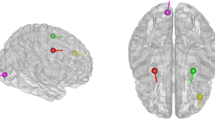Abstract
Neural information flow in brain during meditation, can be addressed by brain connectivity studies. This work aims to obtain neural connectivity measures based on a strictly causal time varying Multi-Variate Auto-Regressive (MVAR) model, fitted to EEG signals obtained during meditation. The time varying Granger Causality based connectivity estimators as PDC (Partial Directed Coherence), g-PDC (generalized Partial Directed Coherence), OPDC (Orthogonalized Partial Directed Coherence) and g-OPDC (generalized Orthogonalized Partial Directed Coherence) are calculated using the adaptive autoregressive MVAR parameters. The MVAR model parameters have been estimated by Kalman Filter algorithm. In this work g-PDC and g-OPDC have been used to make the connectivity measures scale invariant. These connectivity estimators quantify the neural information flow between Electroencephalograph (EEG) channels. In addition g-OPDC is also immune to volume conduction artifact and gives better result compared to g-PDC. Finally, surrogate data statistics has been used to check the significance of the above connectivity estimators.
Access this chapter
Tax calculation will be finalised at checkout
Purchases are for personal use only
Similar content being viewed by others
References
Laskovski A (ed) (2011) Multivariate frequency domain analysis of causal interactions in physiological time series. Biomedical Engineering trends in electronics, communication and software, Intech, pp 403–428
Kaminiski M, Ding M, Truccolo WA, Bressler SL (2001) Evaluating causal relationship in neural systems: granger causality, DTF and statistical assessment of significance. Biol Cybern 85:145–157 (Springer verlag)
Baccala LA, Sameshima K (2001) Partial directed coherence: a new concept in neural structure determination. Biol Cybern 84:463–474 (Springer verlag)
Baccala LA, Sameshima K (2007) Generalized partial directed coherence. In: 15th International IEEE conference on digital signal processing, pp 163–166
Rankine L, Stevenson N, Mesbah M, Boashash B (2007) A non-stationary model of new born EEG. IEEE Trans Bio Med Eng 54(1):19–28
Ting CM, Salleh SH, Zainuddin ZM, Bahar A (2011) Spectral estimation of non stationarity of EEG using particle filtering with application to event related desynchronization. IEEE Trans Bio Eng 58(2):321–331
Hesse W, Moller E, Arnold M, Schack B (2003) The use of time-variant EEG Granger causality for inspecting directed interdependencies of neural assemblies. J Neurosci Methods 123:27–44
Astolfi L, Cincotti F, Mattia D, Fallani F, Tocci A, Colosimo A, Salinari S, Marciani MG, Hesse W, Witte H, Ursino M, Zavaglia M, Babiloni F (2008) Tracking the time varying cortical connectivity patterns by adaptive MV estimation. IEEE Trans Biomed Eng 55(3):902–913
Sommerlade L, Henschel K, Wohlmuth J, Jachan M, Amtage F, Hellwig B, Lückin C, Timmer J, Schelte B (2009) Time variant estimation of directed influences during parkinsonian tremor. J Physiol 103(6):348–352
Faes L, Nollo G (2010) Extended causal modelling to assess PDC in multiple time series with significant instantaneous interaction. Biol Cybern Biol Cybern 103(5):387–400
Nolte G, Bai O, Wheaton L, Mari Z, Vorbach S, Hallett M (2004) Identifying true brain interaction from EEG data using the imaginary part of coherency. Clin Neurophysiol 115:2292–2307
Gomez G (2010) Brain connectivity analysis with EEG. Doctoral dissertation, Department of Signal Processing, Tampere University of Technology
Brookes MV, Woolrich MJ, Luckhoo M, Price H, Hale D, Stephenson JR, Barnes MC, Smith GR, Morris SM, Peter G (2011) Investigating the physiological basis of resting state networks using MEG. Proc Natl Acad Sci USA 108(40):16783–16788
Palva S, Kulashekhar S, Hmalinen, Palva JM (2010) Neural Synchrony reveals working memory networks and predicts individual memory capacity. Proc Natl Acad Sci USA 107:7580–7585
Hipp JF, Hawellek DJ, Corbetta M, Siegel M, Engel AK (2012) Large scale cortical correlation structure of spontaneous oscillatory activity. Nat Neurosci 15:884–890
Omidvarnia A, Azemi G, Boashash B, O’Toole JM, Colditz P, Vanhatalo S (2014) Measuring time varying information flow in scalp EEG signals: orthogonalized partial directed Coherence. IEEE Trans Biomed Eng 61(3):680–693
Murugappan M, Nagarajan R, Yaccob S Discrete wavelet transform based selection of salient EEG frequency band for assessing human emotion. http://cdn.intechopen.com/pdfs.wm/19508.pdf
Kumar P, Arumuganathan R, Sivakumar K, Vimal C (2008) A wavelet based statistical method for denoising of ocular artifacts: artifact in EEG signals. Int J Comput Sci Netw Secur 8(9):87–92
Hytti H, Takalo R, Ihalainen H (2006) Tutorial on multivariate autoregressive modeling. J Clin Monit Comput 20(2):101–108
Koehler AB, Murphree ES (1988) A comparison of akaike and Schwarz criteria for selecting model order. Appl Stat 37(2):187–195
Arnold M, Miltner W, Witte H, Bauer R, Braun C (1998) Adaptive AR modeling of non-stationary time series by means of kalman filtering. IEEE Trans Biomed Eng 45(5):553–562
Schneider T, Neumaier A (2001) Algorithm 808: ARFIT-a Matlab package for the estimation of parameters and eigenmodes of multivariate autoregressive models. ACM-Trans Math Softw 27:58–65
Omidvarnia A, Azemi G, Boashash B, Toole J, Colditz P, Vanhatalo S (2012) Orthogonalized partial directed coherence for functional connectivity analysis of newborn. Neural Inf Proc EEG 7664:683–691
Theiler J, Eubank S, Longtin A, Galdrikian B, Farmer J (1992) Testing of non-linearity in time series: the method of surrogate data. Physica D 58:77–94
Theiler J, Eubank S, Longtin A, Galdrikian B, Farmer D (1992) Testing for nonlinearity in time series: the method of surrogate data. Physica D 58(92):77–94
Hebert R, Lehmann D, Tan G, Travis F, Alexander A (2005) Enhanced EEG alpha time-domain phase synchrony during transcendental meditation: implications for cortical integration theory. J Signal Process 85(11):2213–2232
Tang Y, Rothbart M, Posner MI (2012) Neural correlates of establishing, maintaining, and switching brain states. Trends Cogn sci 16(6):330–337
Author information
Authors and Affiliations
Corresponding author
Editor information
Editors and Affiliations
Rights and permissions
Copyright information
© 2015 Springer India
About this paper
Cite this paper
Shaw, L., Mishra, S., Routray, A. (2015). Generalised Orthogonal Partial Directed Coherence as a Measure of Neural Information Flow During Meditation. In: Gupta, S., Bag, S., Ganguly, K., Sarkar, I., Biswas, P. (eds) Advancements of Medical Electronics. Lecture Notes in Bioengineering. Springer, New Delhi. https://doi.org/10.1007/978-81-322-2256-9_13
Download citation
DOI: https://doi.org/10.1007/978-81-322-2256-9_13
Published:
Publisher Name: Springer, New Delhi
Print ISBN: 978-81-322-2255-2
Online ISBN: 978-81-322-2256-9
eBook Packages: EngineeringEngineering (R0)




